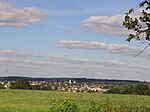Hlučín-Darkovičky Czechoslovak Fortification Complex
1992 establishments in CzechoslovakiaCzech building and structure stubsEuropean museum stubsForts in the Czech RepublicMilitary and war museums in the Czech Republic ... and 4 more
Military of the Czech RepublicMuseums established in 1992Museums in the Moravian-Silesian RegionOpava District

The Hlučín-Darkovičky Czechoslovak Fortification Complex (Czech: Areál československého opevnění Hlučín-Darkovičky) is an exhibition of 1930's military fortifications in Hlučín-Darkovičky, Czech Republic. The forts MO S-18 "Obora", MO S-19 "Alej" and MO S-20 "Orel" are parts of the exhibition. They are part of a series of five different fortifications that were designed to sit on the Czech border during the first half of the 20th century. They are an important example of the defences availables during the World War II and the consequences of the Munich Agreement. The fortification complex has been under the management of the Silesian Museum in Opava since 1992.
Excerpt from the Wikipedia article Hlučín-Darkovičky Czechoslovak Fortification Complex (License: CC BY-SA 3.0, Authors, Images).Hlučín-Darkovičky Czechoslovak Fortification Complex
Roter Bär,
Geographical coordinates (GPS) Address Nearby Places Show on map
Geographical coordinates (GPS)
| Latitude | Longitude |
|---|---|
| N 49.9252 ° | E 18.2213 ° |
Address
Wennsglückt
Roter Bär
37444
Niedersachsen, Deutschland
Open on Google Maps











